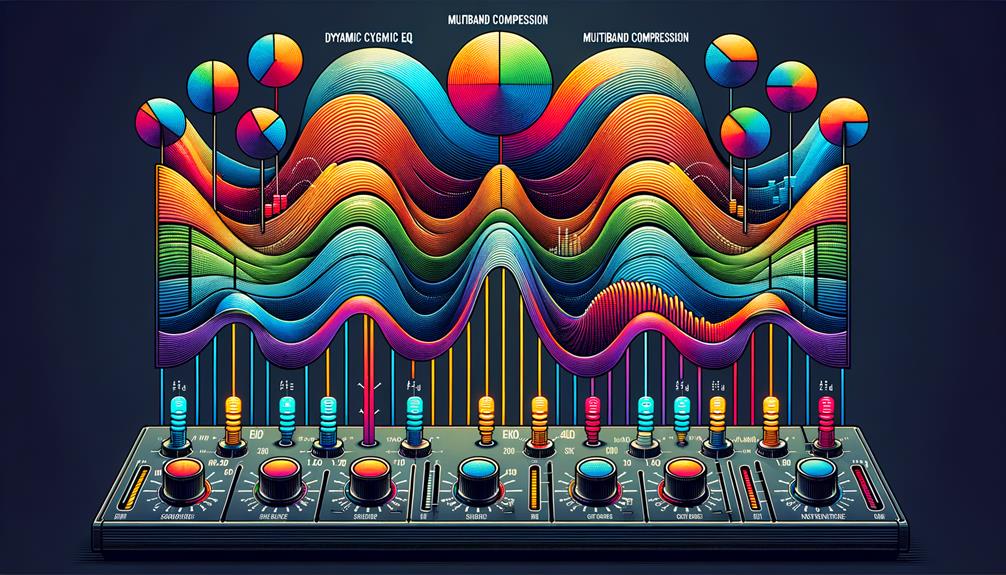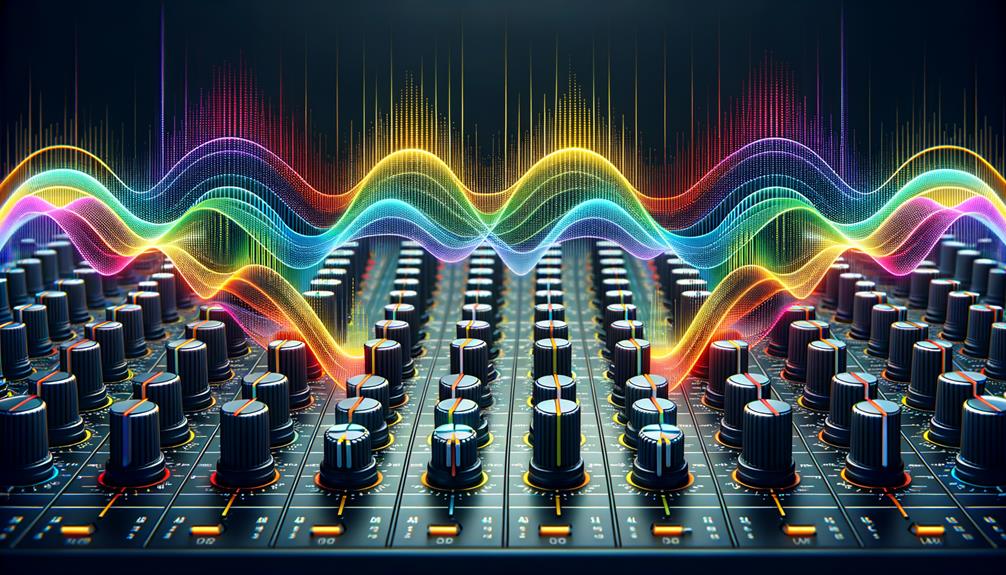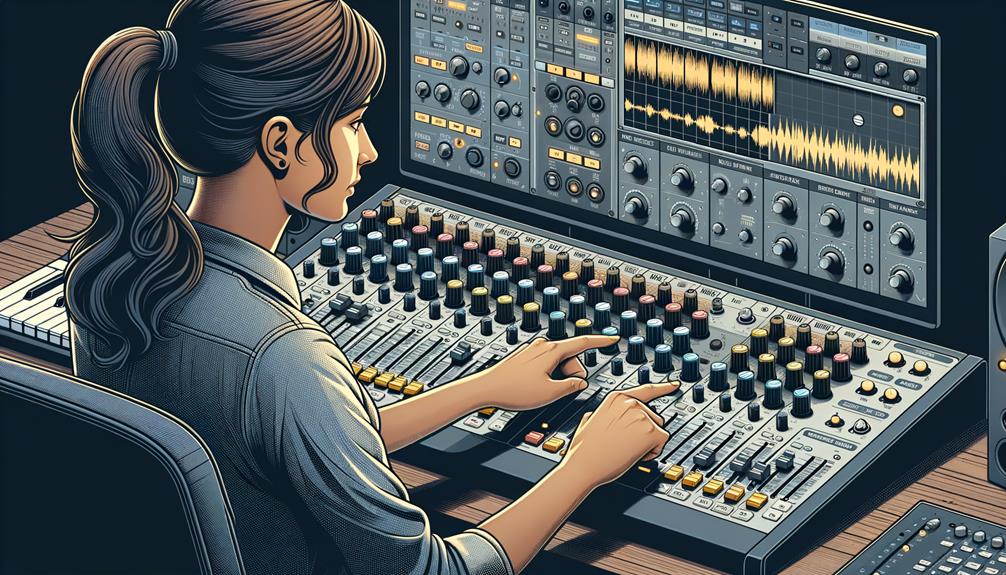No products in the cart.
If you’ve ever thought of traditional EQ as a static snapshot of your audio, then dynamic EQ is like having a smart, adaptable filter that moves and adjusts with the music or sound. It’s a tool that can truly transform your audio production, offering a level of control and precision that static EQ simply can’t match.
But how exactly does it work, and what sets it apart from other dynamic processing tools? Let’s explore how dynamic EQ takes your audio to the next level and why it’s becoming an essential part of the modern mixing and mastering toolkit.
Contents
hide
Key Takeaways
- Dynamic EQ is a powerful tool that combines traditional EQ parameters with dynamic controls.
- It automatically adjusts boosts and cuts based on the characteristics of the incoming signal.
- Dynamic EQ offers a surgical approach to shaping the music mix and can address issues like harshness, boominess, or resonance.
- Compared to static EQ, dynamic EQ provides a more musical and flexible manner of shaping the frequency balance.
Dynamic EQ Defined
Dynamic EQ, when defined, refers to a dynamic processing tool that integrates traditional EQ parameters with dynamic controls to automate boosts and cuts based on the incoming signal’s characteristics. Unlike traditional EQ, dynamic EQ provides the capability to manipulate frequencies based on the signal’s dynamics, offering a more surgical approach to shaping the music mix. By dynamically changing gain values in response to the input signal’s intensity, dynamic EQ behaves akin to a compressor or an expander. This unique feature allows for precise control over specific frequency bands, addressing issues such as harshness, boominess, or resonance in a more musical and flexible manner compared to static EQ.
With dynamic EQ, you have the ability to control individual frequency bands, enabling targeted boosts or cuts only when certain thresholds are met. This level of control is particularly useful for refining the sound of vocals and acoustic instruments, where subtle yet impactful adjustments can be made to enhance the overall quality of the audio. The dynamic nature of this processing tool opens up new possibilities for honing in on problematic frequencies within a mix, providing a versatile and innovative approach to dynamics processing.
How Dynamic EQ Works
When employing dynamic EQ, you can precisely control the dynamic processing of specific frequency bands, allowing for targeted adjustments based on signal thresholds and characteristics. Dynamic EQ works by analyzing the input signal and applying EQ adjustments only when certain criteria are met, providing a more flexible and responsive approach compared to traditional static EQ.
Here’s how dynamic EQ works:
- Flexible Frequency Control: With dynamic EQ, you can target problem frequencies that may vary in intensity over time, addressing them only when they reach a defined threshold.
- Dynamic Processing: Unlike traditional EQs, dynamic EQs use compression techniques to dynamically adjust the gain of specific frequency bands, responding to the input signal’s dynamics.
- Quality Factor and Bandwidth: Dynamic EQ allows for precise control over the quality factor or bandwidth of an EQ, enabling you to fine-tune the affected frequency range with surgical precision.
- Integration with Dynamic Processing Modules: Dynamic EQ modules can be seamlessly integrated with other dynamic processing modules, such as compressors and expanders, to create a comprehensive dynamic processing chain.
Dynamic EQ offers a powerful and innovative approach to frequency control, allowing for targeted adjustments based on the specific characteristics of the input signal.
Dynamic EQ Vs. Multiband Compression

Comparing dynamic EQ to multiband compression reveals distinct differences in their approach to frequency and dynamics processing, providing valuable insights for audio engineers and producers.
Dynamic EQ, a modern mixing tool, automatically adjusts the amount of EQ based on the incoming signal’s intensity, allowing for both cut and boost actions with varying intensity. It blurs the line between frequency and dynamics, offering precise and transparent control over frequency balance.
On the other hand, multiband compression uses steep crossover filters for distinct processing areas, providing a different approach to dynamics control. While dynamic EQ allows the use of any filter shape and offers detailed control over frequency, slope, and Q values, multiband compression typically has predefined bands and crossover points.
Dynamic EQ also provides an extra layer of control over frequency balance, making it effective for attenuating distracting frequencies in louder moments and for highly dynamic sources like vocals and acoustic instruments.
Both dynamic EQ and multiband compression have their unique strengths, and choosing between them depends on the specific requirements of the audio material and the desired processing approach.
Effective Applications of Dynamic EQ
Utilize dynamic EQ to precisely target and attenuate problematic frequencies in your audio signal, providing transparent and effective control over frequency balance. The effective applications of dynamic EQ are numerous, and they include:
- Smoothing out a singer’s voice: When an incoming audio signal contains harsh or piercing frequencies in the singer’s voice, a dynamic EQ band can be used to dynamically control those specific frequencies, providing a more pleasant and balanced vocal performance.
- Taming resonant frequencies: Dynamic EQ can be employed to identify and tame resonant frequencies that may cause muddiness or boomy characteristics in the sound, allowing for a cleaner and more defined frequency content.
- Enhancing drum presence: By using dynamic EQ to target specific drum frequencies, you can achieve greater control over the frequency balance of the drums, allowing for a more consistent and impactful drum sound.
- Managing harshness in guitars: Dynamic EQ is a common use for managing the harsh or shrill frequencies in electric or acoustic guitars, providing precise control over the frequency spectrum and maintaining a smoother and more pleasing tonal quality.
Top Tips for Using Dynamic EQ


After effectively applying dynamic EQ to address specific frequency issues in your audio signal, it’s essential to consider top tips for using dynamic EQ to further enhance your sound shaping capabilities. When working with dynamic EQ, it’s crucial to analyze the incoming signal and identify areas where it may sound thin or where certain frequencies become overwhelming.
Instead of using a fixed gain, consider using dynamic EQ to boost certain frequencies when they get lost in the mix, providing better control over the sound. Additionally, utilizing Q values in dynamic EQ allows for precise adjustments to specific frequencies, offering a more targeted approach compared to traditional subtractive EQ.
For an even more refined sound, consider employing sidechain inputs to trigger dynamic EQ, allowing for more controlled and targeted frequency adjustments. This method is particularly useful for addressing momentary resonances in vocals or instruments, unmasking instruments from each other, and carving out space in your mix.
Lastly, choosing the right dynamic EQ plugin for your specific needs is crucial. By following these top tips, you can effectively enhance your sound shaping capabilities, especially when working with dynamic EQ on a bass track or vocals.
Frequently Asked Questions
When Should I Use Dynamic Eq?
You should use dynamic EQ for live performances, studio recording, vocal processing, drum mixing, guitar shaping, bass enhancement, mastering techniques, dynamic range control, frequency sculpting, and audio restoration. It provides precise, transparent control over frequency balance.
How Does a Dynamic EQ Differ From a Traditional EQ?
Dynamic EQ differs from traditional EQ by automatically adjusting based on the incoming signal, offering precise and transparent control. It behaves like a combination of EQ and compression, providing extra control for highly dynamic sources like vocals and acoustic instruments.
What Is the Difference Between Parametric and Dynamic Eq?
In audio engineering, dynamic EQ and parametric EQ both relate to frequency bands and sound shaping. Dynamic EQ dynamically adjusts frequency response based on audio levels, while parametric EQ provides static control over specific frequency bands.
What Is the Difference Between Equalizer Dynamic and Normal?
In audio mixing, a dynamic equalizer differs from a normal equalizer by adjusting frequency levels based on signal strength, acting like a hybrid of an equalizer and a compressor. The dynamic EQ offers more precise control and is beneficial for dynamic sources.
Conclusion
In conclusion, dynamic EQ is a versatile audio processing tool that combines the benefits of traditional EQ with dynamic control. Its ability to automatically adjust EQ based on the characteristics of the incoming signal allows for precise and transparent frequency balance control.
When compared to multiband compression, dynamic EQ offers a more targeted approach to frequency manipulation, making it particularly effective for attenuating distracting frequencies in louder moments and for highly dynamic sources such as vocals and acoustic instruments.




